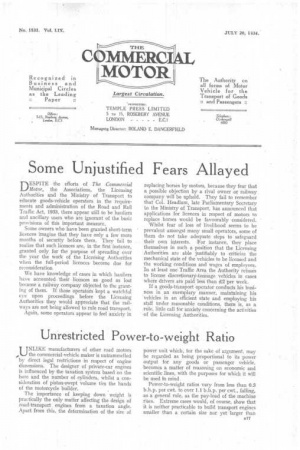Unrestricted Power-to-weight Ratio
Page 31

Page 32

If you've noticed an error in this article please click here to report it so we can fix it.
TNLIKE manufacturers of other road motors the commercial-vehicle maker is untrammelled by direct legal restrictions in respect of engine dimensions. The designer of private-car engines is influenced by the taxation system based on the bore and the number of cylinders, whilst a consideration of piston-swept volume ties the hands of the motorcycle builder.
The importance of keeping down weight is practically the only matter affecting the design of road-transport engines from a taxation angle. Apart from this, the determination of the size of power unit which, for the sake of argument, may be regarded as being proportional to its power output for any goods or passenger vehicle, becomes a matter of reasoning on economic and scientific lines, with the purposes for which it will be used fn mind Power-to-weight ratios vary from less than 0.3 b.h.p. per cwt. to over 1.1 b.h.p. per cwt., falling, as a general rule, as the pay-load of the machine rises. Extreme cases would, of course, show that it is neither practicable to build transport engines smaller than a certain size nor yet larger than another given capacity. But that throws no light on a consideration of machines within these limits.
Doubtless makers are first influenced by the actions of their competitors. Thus, the power-toweight ratio for a chassis in any class will have to be between, let us say, 0.3 and 0.6 b.h.p. per cwt. The bigger the figure the greater will be the acceleration and speed up hill A gearbox providing a larger number of gear ratios, however, may enable the lower-powered machine to compete with that having the larger engine.
Given similar operating conditions, a high power-to-weight ratio means that the engine will, for possibly the greater part of its life, be driven at only a fraction of full-throttle opening. It may, therefore, be designed with inferior properties of durability and yet last as long as a smaller power unit that will be driven harder. Thus, it will be cheaper to produce and probably lighter.
The question then arises as to whether less fuel is consumed by the large engine at half-throttle or the small engine at full throttle for the same work done. A general answer cannot be given, so the designer should make it his business to see that the consumption curve is low at the output and speed at which the engine normally works.
Remembering the excellent service being regularly rendered by engines built for 2-tonners installed in chassis adapted to carry much bigger loads, and bearing in mind the advantage of a lorry of low unladen weight, there would seem to be an opening for a lightweight vehicle, say, not exceeding 11 ton, with a load capacity of, perhaps, ai tons and having an engine giving a power-to-weight ratio not greater than 0.4 b.h.p. per cwt. gross weight.
Stricter Maintenance Now Essential
(-NNE inevitable effect of the operation of the ‘..../Road and Rail Traffic Act will be to impress users with the importance of maintenance as an item of operating costs. Hitherto, in far too many cases, the work and the cost alike have been neglected, to the detriment of the status of the road-transport industry as a whole. The first signs of a change of heart in this matter are already to be seen as the result of visits made by examiners under the Act.
The next phase will begin with the keeping and inspection of records of hours of work, when it will become evident that it is not going to be practicable to expect a driver to do the majority of small maintenance operations and, at the same time, drive the vehicle to the satisfaction of his employer. Maintenance will have to be arranged for in some other way, albeit at some slight extra expense.
The third and most important phase will be the appreciation of the value of investing in up-to-date equipment as being the most satisfactory method of attaining economical working.




























































































